The First National Bank Of Denver
The First National Bank Of Denver in Colorado printed $12,585,770 dollars worth of national currency. Once a bank issues that much money there really isn’t much room for rare issues. However, there are certainly exceptions to every rule. This national bank opened in 1865 and stopped printing money in 1935, which equals a 71 year printing period. That is considering a long operation period for a national bank. During its life, The First National Bank Of Denver issued 35 different types and denominations of national currency. We have examples of the types listed below. Your bank note should look similar. Just the bank name will be different. For the record, The First National Bank Of Denver was located in Denver County. It was assigned charter number 1016.
We buy all national currency. Please call or email us for a quote. Sales@AntiqueMoney.com
The First National Bank Of Denver in Colorado issued 1,000 sheets of $1 original series territorial national bank notes. A total sheet output in the lows 1,000s is a great sign that you own a very rare bank note. When dealing with any first charter one dollar bank note, you can always take the number of sheets printed and multiply it by three to get the total number of actual bank notes printed for this denomination. These are technically called original series one dollar territorial national bank notes. Most collectors just call them territorial aces. Believe it or not, they are actually quite available. Around 100 of them are known to exist. Thanks to small hoards from towns like Salt Lake City, Yankton, and Denver, a collector can buy a nice looking territorial ace without spending tens of thousands of dollars. The rarest examples will certainly still cost more than $10,000, but others can seem like bargains.
Original Series $1 Territorial National Bank Note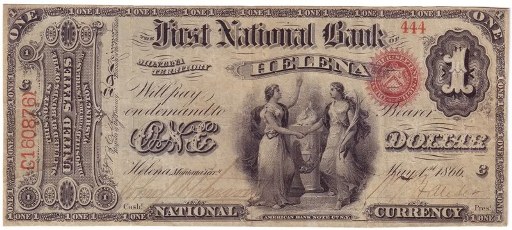
The First National Bank Of Denver printed 1,000 sheets of $2 original series territorial national bank notes. Keep in mind that there was just one two dollar bill printed per sheet. So in this case the sheet number equals the total output of notes. Just like with the one dollar denomination, original series $2 territorial bank notes have survived at a surprisingly high rate considering they were only issued by 19 different national banks. The good news for sellers is that these are still really valuable. Prices are as low as $10,000 for something ugly and relatively common. It is possible for the rarest examples to be worth more than $50,000.
Original Series $2 Territorial National Bank Note
The First National Bank Of Denver also printed 1,250 sheets of $5 original series territorial national bank notes. A total sheet output in the lows 1,000s is a great sign that you own a very rare bank note. You can do some quick math and take the sheet output, multiply it by four, and get the total number of original series $5 territorial bank notes issued by this bank. Only 30 banks in the country even printed these notes. Today there are only about ten surviving examples known to exist. Most of them are low grade and they are rarely available on the collector market. We are talking about bank notes printed before 1875, so the number of new discoveries being found 140 years later is minimal. Prices range from a few thousand dollars to tens of thousands of dollars based on any number of valuation factors.
Original Series $5 Territorial National Bank Note
The First National Bank Of Denver also printed 4,400 sheets of $10 original series territorial national bank notes. That printing range is high enough to allow for a couple of survivors, but not much more. Now here is an amazing fact. We know that 42 national banks printed this type of bank note, yet only four examples are known to exist. That population of four is split between two banks in Denver. So the question becomes, what happened to the rest of them? The easiest explanation is that no one knew these would ever become rare and collectible, so they got spent and eventually destroyed by the government upon redemption. Any original series ten dollar bill from a bank other than Denver would certainly be a welcome find.
Original Series $10 Territorial National Bank Note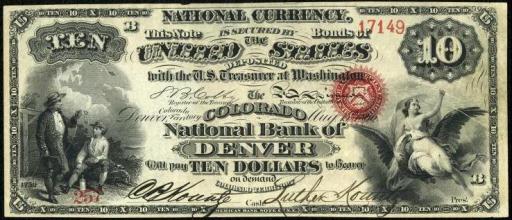
The First National Bank Of Denver also printed 4,400 sheets of $20 original series territorial national bank notes. In this case, the number printed really doesn’t matter because so few are still outstanding. Seventeen different banks printed original series $20 territorial national bank notes. And just like with the ten dollar denomination, just four $20 bills are known to exist and they all happen to be from Denver. Other national banks in Idaho, Montana, Nebraska, New Mexico, Utah, and Wyoming all issued these notes. For some reason though, the collecting world has yet to find a survivor from any of those states.
Original Series $20 Territorial National Bank Note
The First National Bank Of Denver also printed 340 sheets of $50 original series territorial national bank notes. Collectors love to buy notes from such a small print run. It doesn’t get much smaller than under 500 sheets printed. This is one of the last great discoveries waiting to be found in the world of territorial bank notes. A total of nine different national banks printed original series first charter $50 territorial bank notes. However, none of their issues have yet to be found. Odds are that one or two are hiding somewhere. When, where, and how they will be found is still a mystery.
Original Series $50 Territorial National Bank Note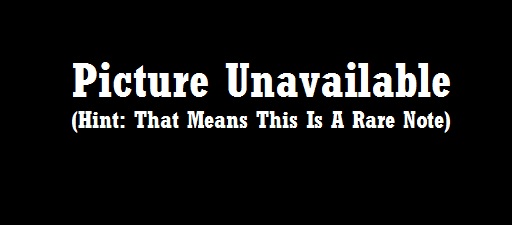
The First National Bank Of Denver also printed 340 sheets of $100 original series territorial national bank notes. With a number that small, you can see why these are so rare. You can throw the printing number out the window, because none of that matters. The simple fact is that only four banks printed original series $100 territorial bank notes and there are currently no survivors known to exist.
Original Series $100 Territorial National Bank Note
The First National Bank Of Denver also printed 350 sheets of $5 series of 1875 territorial national bank notes. Collectors love to buy notes from such a small print run. It doesn’t get much smaller than under 500 sheets printed. Most first charter five dollar territorials that we encounter today are from the series of 1875. Despite saying series of 1875, these were actually printed as late as 1901 by a handful of banks. So while these might appear ancient, some are much newer than the series date would suggest. With that said, these are still rare items treasured by collectors. Exactly 42 national banks printed series of 1875 five dollar territorials. That list of banks pretty much included all of the territories from Arizona to Wyoming. Please give us a chance to help you establish the value of your note. You will likely be pleasantly surprised with how these bank notes are valued in today’s market.
Series of 1875 $5 Territorial National Bank Note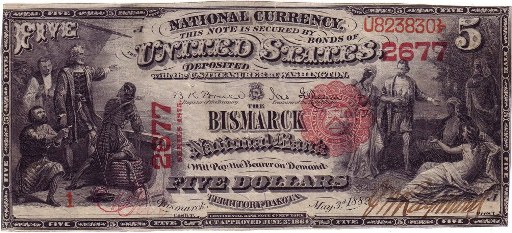
The First National Bank Of Denver also printed 1,475 sheets of $10 series of 1875 territorial national bank notes. A total sheet output in the lows 1,000s is a great sign that you own a very rare bank note. Thirty-two different banks printed series of 1875 $10 territorial bank notes. There is a nice mix of notes from states like North Dakota and some Western states as well. Prices for these range from high four figures to low five figures. Of course condition, bank, or serial number rarities could command more money. This is often the first type of bank note issued by pioneer banks in very remote areas. The survival number currently stands at 16 examples, but we usually handle a new discovery at least once a year, so that number is slowly rising, but this will never been a common bank note.
Series of 1875 $10 Territorial National Bank Note
The First National Bank Of Denver also printed 1,475 sheets of $20 series of 1875 territorial national bank notes. Don’t get too caught up on the number of sheets printed. Twenty dollar series of 1875 territorial bank notes are very rare. They were only printed by 28 banks and only six unique notes are known to exist to collectors. This is the rarest denomination (below $50) for first charter territorials.
Series of 1875 $20 Territorial National Bank Note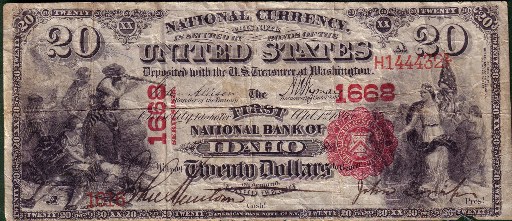
The First National Bank Of Denver also printed 1,333 sheets of $50 series of 1875 territorial national bank notes. A total sheet output in the lows 1,000s is a great sign that you own a very rare bank note. A total of just seven national banks even printed series of 1875 $50 territorial bank notes. Right now only two notes are known to exist. One is from Salt Lake City (as pictured) the other is from Denver.
Series of 1875 $50 Territorial National Bank Note
The First National Bank Of Denver also printed 1,333 sheets of $100 series of 1875 territorial national bank notes. Needless to say, that is not many sheets. There really isn’t much to say about series of 1875 territorial $100 bank notes. Only one is known to exist and it is part of a very advanced collection. The next discovery will be significant and quite valuable.
Series of 1875 $100 Territorial National Bank Note
The First National Bank Of Denver also printed 13,600 sheets of $5 1882 brown back national bank notes. When we start talking about a printing number in the five figure range, then you are likely not dealing with a great rarity. However, the note could certainly still be popular and valuable. You can take the total number of sheets printed and multiply that number by four to get the exact number of 1882 $5 brown back bank notes this bank issued. Each note has a portrait of James Garfield on the left hand side of the bill. These are very popular with collectors because they have different text layouts. Some notes are worth as little as a few hundred dollars, but most are worth a good deal more.
Series of 1882 $5 Brown Back
The First National Bank Of Denver also printed 5,196 sheets of $10 1882 brown back national bank notes. A print range between 5,000 and 10,000 suggests that there should be at least a couple of notes known to exist. There were three $10 bills printed on a single sheet of 1882 brown backs. The design of the bill is similar to all earlier ten dollar national bank notes. The nickname comes from the fact that these bills have a brown seal and brown overprint. Despite saying series of 1882, these were actually printed by some banks up until 1908. The date you see in cursive relates to when the bank first started issuing brown back notes.
Series of 1882 $10 Brown Back
The First National Bank Of Denver also printed 5,196 sheets of $20 1882 brown back national bank notes. As you can see, the sheet output is the same for $20 brown backs as it is for $10 brown backs. There was only one $20 brown back printed on a sheet. So the sheet output also equals the total note output. One neat thing about all brown backs is that they each have a different back design based on which state issued them. The back left hand side of the note shows the state seal of which ever state the national bank was located in. Generally speaking, 1882 $20 brown backs are pretty difficult to locate. They typically were printed in small numbers and they don’t have a great survival rate.
Series of 1882 $20 Brown Back
The First National Bank Of Denver also printed 9,452 sheets of $50 1882 brown back national bank notes. Not many banks printed $50 1882 brown backs. Sheet outputs aren’t extremely important. However, it is good factual information to know. The most common 1882 $50 brown backs are worth about $5,000. However, some can be worth more than $10,000 based on condition, serial number, and bank of issue.
Series of 1882 $50 Brown Back
The First National Bank Of Denver also printed 9,452 sheets of $100 1882 brown back national bank notes. Just because this bank printed more than 1,000 one hundred dollar brown backs does not mean that they are all common. We are very interested in purchasing $100 1882 brown back national bank notes. We have paid more than $15,000 for some examples. Send us pictures of what you have and we will respond quickly with an appraisal and offer.
Series of 1882 $100 Brown Back
The First National Bank Of Denver also printed 32,100 sheets of $5 1902 red seal national bank notes. Very few national banks printed more than 10,000 red seal sheets. Five dollar red seals are typically a little bit rarer than some higher denominations. That rarity is typically just a result of small issuances. Most national banks preferred to issue $10 and $20 1902 red seals. Each one of these five dollar bank notes has a portrait of Ben Harrison on the left hand side of the bill. Most people are quick to notice the cursive charter date with a year between 1902 and 1908 written on it. That date will never affect the value.
1902 $5 Red Seal National Bank Note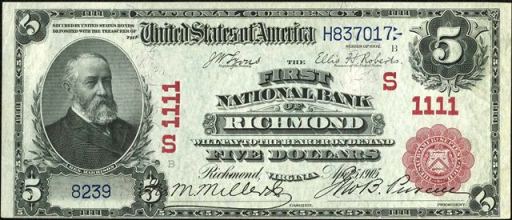
The First National Bank Of Denver also printed 8,800 sheets of $10 1902 red seal national bank notes. That may sound like a high number. However, red seals did not survive in large numbers. It is likely still quite rare. Collectors love ten dollar 1902 red seals. They usually represent the rarest bank notes printed by any national bank. Don’t let the term “series of 1902” confuse you. These were actually printed for about six years between 1902 and 1908. That is obviously a very short issue period which means that many red seals are quite rare. Each note has a portrait of William McKinley. Be sure to check the number under McKinley. If it is #1 then you are dealing with a note from the first sheet of bank notes issued. Number one bank notes are worth even more money than the already rare red seals.
1902 $10 Red Seal National Bank Note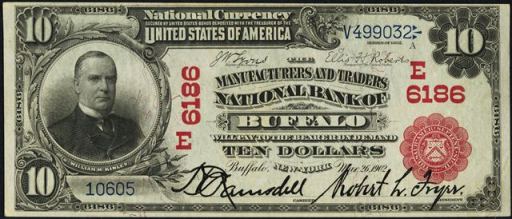
The First National Bank Of Denver also printed 8,800 sheets of $20 1902 red seal national bank notes. Twenty dollar red seal bank notes have poor survival rates. They don’t command premiums compared to the ten dollar denomination, but they are definitely rarer. All 1902 red seals were printed on four note sheets. There were three ten dollar bills and one twenty dollar bill per sheet. The 1902 $20 notes have a portrait of Hugh McCulloch on them. The charter number and seal are both printed in red ink. The serial numbers have a slight blue tint to them. The charter number is printed around the border of the note several times. The bank’s title is right in the middle of the note and the state of issue is printed just below the title. Remember that all national bank notes are valued based on their condition and rarity. The same rule applies to 1902 $20 red seals.
1902 $20 Red Seal National Bank Note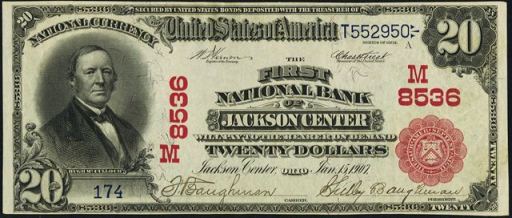
The First National Bank Of Denver also printed 2,320 sheets of $50 1902 red seal national bank notes. That is also the exact number of $50 red seals printed by this bank. Each sheet contained one $50 bill and one $100 bill. They are all extremely rare. The value for a generic circulated example is usually around $4,000. Most are worth more and some can be worth considerably more. John Sherman is pictured on each note. Otherwise it has the same markings you would expect to find on any 1902 red seal.
1902 $50 Red Seal National Bank Note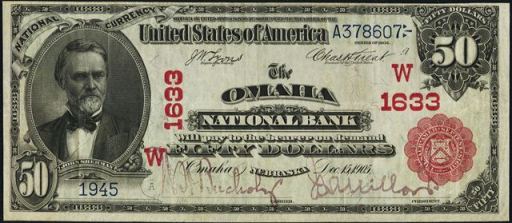
The First National Bank Of Denver also printed 2,320 sheets of $100 1902 red seal national bank notes. As we said above, all high denomination 1902 red seals are extremely rare. The number of notes printed really doesn’t matter to collectors. 1902 $100 red seals are rare to the point that they are always in demand. Of course the standard valuation rules still apply. Condition and bank of issue are of paramount importance. We have paid over $12,000 for some of the rarest specimens.
1902 $100 Red Seal National Bank Note
The First National Bank Of Denver also printed 89,300 sheets of $5 1902 blue seal national bank notes. Sadly, a printing range that high means that these blue seal bank notes from this bank are not going to be extremely rare. Ben Harrison is on the front of all 1902 $5 blue seal bank notes. This happens to be the smallest denomination issued for the 1902 series. Each note is complete with a blue seal and blue charter number. Despite saying series of 1902, these were actually issued by national banks between 1908 and 1928. There are two different types of blue seals. The first type is called a date back and it has “1902-1908” written on the back of the bill. The other type is called a plain back; it does not have the date stamps on the back of the bill. The values for these notes range widely based on condition and the bank of issue.
1902 $5 Blue Seal National Bank Note
The First National Bank Of Denver also printed 74,299 sheets of $10 1902 blue seal national bank notes. Sadly, a printing range that high means that these blue seal bank notes from this bank are not going to be extremely rare. 1902 $10 blue seal bank notes all have a portrait of William McKinley on them. Values can range from as little as $40 up to over $10,000. There really is no trick to know what is rare and what is common by just doing an internet search. You really need to work with an expert (like us) in order to determine the value of your specific bank note. There are at least ten different factors than can make some 1902 $10 blue seals worth more than others. We know exactly what to look for and we would be happy to provide a free appraisal and our best offer.
1902 $10 Blue Seal National Bank Note
The First National Bank Of Denver also printed 74,299 sheets of $20 1902 blue seal national bank notes. The same rarity rules for 1902 $10 blue seals also apply to $20 blue seals. Just remember that $20 bills are by nature three times rarer (unfortunately they don’t command a premium over other denominations). Hugh McCulloch is pictured on the front of each bill. Contact us if you need pricing help.
1902 $20 Blue Seal National Bank Note
The First National Bank Of Denver also printed 1,000 sheets of $50 1902 blue seal national bank notes. There is no trick to knowing which 1902 blue seals will be common and rare. Often times the number printed won’t tell you much information. The value still comes down to condition and demand. That is a surprise to most people. In fact, most 1902 $50 bills we see are worth between $750 and $1,250. The rarer ones can be worth more than $5,000. However, there isn’t much middle ground.
1902 $50 Blue Seal National Bank Note
The First National Bank Of Denver also printed 1,000 sheets of $100 1902 blue seal national bank notes. It is no coincidence that the sheet numbers for $50 bills and $100 bills are the same. They were printed on the same sheets. Most $100 blue seals are at least scarce; others can be very rare. John J Knox is printed on the front of each bill. Most collectors like the back design a lot more though. It is really unique and different from most other national bank notes. Prices for 1902 $100 blue seals are pretty similar to $50 blue seals. They are both equally common or equally rare, depending on how you look at it.
1902 $100 Blue Seal National Bank Note
The First National Bank Of Denver also printed 14,204 sheets of Type1 1929 $5 national bank notes. Sadly, based on a number that high, there is basically no chance for these notes to be especially rare. Every 1929 $5 bill has a portrait of Abraham Lincoln on it. This is also the lowest denomination of small size national currency that any bank issued. All serial numbers end with the letter A and start with a letter between A and F. Remember that you can take the total number of sheets printed and multiply it by six get to the actual number of bank notes printed for this denomination. All small size national bank notes were printed on sheets of six.
Series of 1929 Type1 $5 National Bank Note
The First National Bank Of Denver also printed 10,160 sheets of Type1 1929 $10 national bank notes. Sadly, based on a number that high, there is basically no chance for these notes to be especially rare. Each $10 bill from 1929 has a portrait of Alexander Hamilton on it. The black number written vertically is the charter number. The charter number never affects the value; it is just an identifier. The ten dollar type1 national bank note happens to be the single most common national bank note, with over 65,000 known to exist from all banks. Of course each note is valued based on its condition and rarity. Some are very rare.
Series of 1929 Type1 $10 National Bank Note
The First National Bank Of Denver also printed 3,602 sheets of Type1 1929 $20 national bank notes. That is a pretty typical sheet output for a national bank during the small size era. Andrew Jackson is featured on the front of each 1929 $20 bill. Be sure to take note of the serial number on your specific bank note. If it is 000001 then you can expect a nice premium. There is a special market for serial number one bank notes. Of course, even if the number isn’t #1, it could still be collectible and have a high value just based on its condition and rarity alone.
Series of 1929 Type1 $20 National Bank Note
The First National Bank Of Denver also printed 616 sheets of Type1 1929 $50 national bank notes. This is a small print range, but it does not guarantee rarity. As is the case with all modern fifty dollar bills, Ulysses Grant is pictured on the front of 1929 $50 bills. This is a higher denomination that was only printed by 300 different national banks. Many examples are only worth around a few hundred dollars. Rarer specimens can sell for more than $1,000.
Series of 1929 Type1 $50 National Bank Note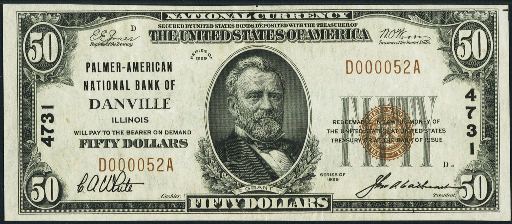
The First National Bank Of Denver also printed 316 sheets of Type1 1929 $100 national bank notes. That may sound like a very small number, and it is. However, when it comes to small size notes, that print range usually allows for a handful of survivors. Despite saying series of 1929, all type1 national bank notes were actually printed between 1929 and 1933. Exactly 289 national banks printed $100 type1 notes. Most are relatively common. However, as with anything, there are always exceptions to that rule.
Series of 1929 Type1 $100 National Bank Note
The First National Bank Of Denver also printed 69,626 individual notes from the type2 1929 $5 national bank note series. That is a high printing total. Don’t expect much rarity here, but condition factors can always make common items more valuable. This was an easy and popular denomination for national banks. Five dollars could buy a lot of different things back in 1929 and the early 1930s. 1929 type2 five dollar bank notes are available in quantities today. However, some notes can be extremely rare. The exact value all depends on the bank of issue and condition. Contact us and we would be happy to give a free appraisal.
Series of 1929 Type2 $5 National Bank Note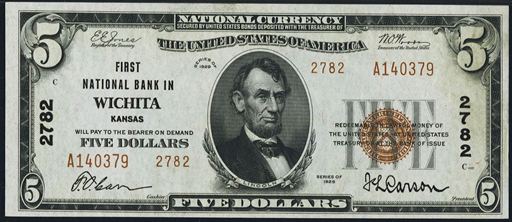
The First National Bank Of Denver also printed 31,093 individual notes from the type2 1929 $10 national bank note series. That is a high printing total. Don’t expect much rarity here, but condition factors can always make common items more valuable. The easiest way to spot the difference between type1 1929 $10 bills and 1929 type2 $10 bills is in the serial number. Type2 notes have a serial number that ends with a number. 1929 type1 notes have a serial number that ends with the letter A. Generally speaking, these $10 bills are rarer than the earlier type1 issues. However, most collectors don’t pay more for that rarity because they look basically the same.
Series of 1929 Type2 $10 National Bank Note
The First National Bank Of Denver also printed 11,105 individual notes from the type2 1929 $20 national bank note series. This is a pretty typical print run for type2 national bank notes. Values will be across the board based on demand. One of the great things about 1929 type2 $20 national bank notes is that they really aren’t that old and some can be extremely rare. Until the big head $20 series started there really wasn’t much difference between something printed in 1929 and the same bill printed in 1993. We have bought some examples in the past few months that people just found in their change.
Series of 1929 Type2 $20 National Bank Note



